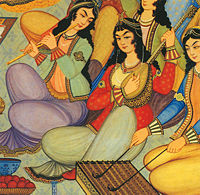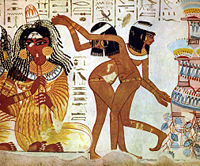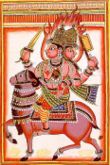Culture
2008/9 Schools Wikipedia Selection. Related subjects: Everyday life
Culture (from the Latin cultura stemming from colere, meaning "to cultivate,") generally refers to patterns of human activity and the symbolic structures that give such activities significance and importance. Cultures can be "understood as systems of symbols and meanings that even their creators contest, that lack fixed boundaries, that are constantly in flux, and that interact and compete with one another"
Culture can be defined as all the ways of life including arts, beliefs and institutions of a population that are passed down from generation to generation. Culture has been called "the way of life for an entire society." As such, it includes codes of manners, dress, language, religion, rituals, norms of behaviour such as law and morality, and systems of belief as well as the art.
Cultural anthropologists most commonly use the term "culture" to refer to the universal human capacity and activities to classify, codify and communicate their experiences materially and symbolically. Scholars have long viewed this capacity as a defining feature of humans (although some primatologists have identified aspects of culture such as learned tool making and use among humankind's closest relatives in the animal kingdom).

Culture concept(s)
Culture and anthropology
Culture is manifested in human artifacts and activities such as music, literature, lifestyle, food, painting and sculpture, theatre and film. Although some scholars identify culture in terms of consumption and consumer goods (as in high culture, low culture, folk culture, or popular culture), anthropologists understand "culture" to refer not only to consumption goods, but to the general processes which produce such goods and give them meaning, and to the social relationships and practices in which such objects and processes become embedded. For them, culture thus includes art, science, as well as moral systems.
Various definitions of culture reflect differing theories for understanding, or criteria for evaluating, human activity. Writing from the perspective of social anthropology in the UK, Tylor in 1874 described culture in the following way: "Culture or civilization, taken in its wide ethnographic sense, is that complex whole which includes knowledge, belief, art, morals, law, custom, and any other capabilities and habits acquired by man as a member of society."
More recently, the United Educational, Scientific and Cultural Organization (Unesco) (2002) described culture as follows: "... culture should be regarded as the set of distinctive spiritual, material, intellectual and emotional features of society or a social group, and that it encompasses, in addition to art and literature, lifestyles, ways of living together, value systems, traditions and beliefs".
While these two definitions cover a range of meaning, they do not exhaust the many uses of the term "culture." In 1952, Alfred Kroeber and Clyde Kluckhohn compiled a list of 164 definitions of "culture" in Culture: A Critical Review of Concepts and Definitions.
These definitions, and many others, provide a catalog of the elements of culture. The items cataloged (e.g., a law, a stone tool, a marriage) each have an existence and life-line of their own. They come into space-time at one set of coordinates and go out of it another. While here, they change, so that one may speak of the evolution of the law or the tool.
A culture, then, is by definition at least, a set of cultural objects. Anthropologist Leslie White asked: "What sort of objects are they? Are they physical objects? Mental objects? Both? Metaphors? Symbols? Reifications?" In Science of Culture (1949), he concluded that they are objects " sui generis"; that is, of their own kind. In trying to define that kind, he hit upon a previously unrealized aspect of symbolization, which he called "the symbolate"—an object created by the act of symbolization. He thus defined culture as "symbolates understood in an extra-somatic context." The key to this definition is the discovery of the symbolate.
Culture as civilization
Many people have an idea of "culture" that developed in Europe during the 18th and early 19th centuries. This notion of culture reflected inequalities within European societies, and between European powers and their colonies around the world. It identifies "culture" with "civilization" and contrasts it with "nature." According to this way of thinking, one can classify some countries and nations as more civilized than others, and some people as more cultured than others. Some cultural theorists have thus tried to eliminate popular or mass culture from the definition of culture. Theorists such as Matthew Arnold (1822-1888) or the Leavisites regard culture as simply the result of "the best that has been thought and said in the world.” Arnold contrasted mass/popular culture with social chaos or anarchy. On this account, culture links closely with social cultivation: the progressive refinement of human behaviour. Arnold consistently uses the word this way: "...culture being a pursuit of our total perfection by means of getting to know, on all the matters which most concern us, the best which has been thought and said in the world."
In practice, culture referred to élite activities such as museum-caliber art and classical music, and the word cultured described people who knew about, and took part in, these activities. These are often called " high culture", namely the culture of the ruling social group, to distinguish them from mass culture or popular culture.
From the 19th century onwards, some social critics have accepted this contrast between the highest and lowest culture, but have stressed the refinement and sophistication of high culture as corrupting and unnatural developments that obscure and distort people's essential nature. On this account, folk music (as produced by working-class people) honestly expresses a natural way of life, and classical music seems superficial and decadent. Equally, this view often portrays Indigenous peoples as ' noble savages' living authentic unblemished lives, uncomplicated and uncorrupted by the highly-stratified capitalist systems of the West.
Today most social scientists reject the monadic conception of culture, and the opposition of culture to nature. They recognize non- élites as just as cultured as élites (and non-Westerners as just as civilized)—simply regarding them as just cultured in a different way.
Culture as worldview
During the Romantic era, scholars in Germany, especially those concerned with nationalist movements — such as the nationalist struggle to create a "Germany" out of diverse principalities, and the nationalist struggles by ethnic minorities against the Austro-Hungarian Empire — developed a more inclusive notion of culture as " worldview." In this mode of thought, a distinct and incommensurable worldview characterizes each ethnic group. Although more inclusive than earlier views, this approach to culture still allowed for distinctions between "civilized" and "primitive" or "tribal" cultures.
By the late 19th century, anthropologists had adopted and adapted the term culture to a broader definition that they could apply to a wider variety of societies. Attentive to the theory of evolution, they assumed that all human beings evolved equally, and that the fact that all humans have cultures must in some way result from human evolution. They also showed some reluctance to use biological evolution to explain differences between specific cultures — an approach that either exemplified a form of, or segment of society vis a vis other segments and the society as a whole, they often reveal processes of domination and resistance.
In the 1950s, subcultures — groups with distinctive characteristics within a larger culture — began to be the subject of study by sociologists. The 20th century also saw the popularization of the idea of corporate culture — distinct and malleable within the context of an employing organization or a workplace.
Culture as symbols
The symbolic view of culture, the legacy of Clifford Geertz (1973) and Victor Turner (1967), holds symbols to be both the practices of social actors and the context that gives such practices meaning. Anthony P. Cohen (1985) writes of the "symbolic gloss" which allows social actors to use common symbols to communicate and understand each other while still imbuing these symbols with personal significance and meanings. Symbols provide the limits of cultured thought. Members of a culture rely on these symbols to frame their thoughts and expressions in intelligible terms. In short, symbols make culture possible, reproducible and readable. They are the "webs of significance" in Weber's sense that, to quote Pierre Bourdieu (1977), "give regularity, unity and systematics to the practices of a group." Thus, for example:
- "Stop, in the name of the law!"—Stock phrase uttered to the antagonists by the sheriff or marshal in 20th century American Old Western films
- Law and order— stock phrase in the United States
- Peace and order—stock phrase in the Philippines
Culture as a stabilizing mechanism
Modern cultural theory also considers the possibility that (a) culture itself is a product of stabilization tendencies inherent in evolutionary pressures toward self-similarity and self-cognition of societies as wholes, or tribalisms. See Stephen Wolfram's A New Kind of Science on iterated simple algorithms from genetic unfolding, from which the concept of culture as an operating mechanism in can be developed on Friday, and Richard Dawkins' The Extended Phenotype for discussion of genetic and memetic stability over time, through negative feedback mechanisms.
Culture and evolutionary psychology
Researchers in evolutionary psychology argue that the mind is a system of neurocognitive information processing modules designed by natural selection to solve the adaptive problems of our distant ancestors. According to evolutionary psychologists, the diversity of forms that human cultures take are constrained (indeed, made possible) by innate information processing mechanisms underlying our behaviour, [Citation Needed] including:
- Agent detection mechanisms
- Alliance-tracking mechanisms
- Cheater detection mechanisms
- Fear and protection mechanisms (survival mechanisms)
- Foraging mechanisms
- Incest avoidance mechanisms
- Intelligence and sex-specific mating preferences
- Language acquisition modules
These mechanisms are theorized to be the psychological foundations of culture. In order to fully understand culture we must understand its biological conditions of possibility. [Citation Needed]
Cultures within a society
Large societies often have subcultures, or groups of people with distinct sets of behaviour and beliefs that differentiate them from a larger culture of which they are a part. The subculture may be distinctive because of the age of its members, or by their race, ethnicity, class, or gender. The qualities that determine a subculture as distinct may be aesthetic, religious, occupational, political, sexual, or a combination of these factors.
In dealing with immigrant groups and their cultures, there are essentially four approaches:
- Leitkultur (core culture): A model developed in Germany by Bassam Tibi. The idea is that minorities can have an identity of their own, but they should at least support the core concepts of the culture on which the society is based.
- Melting Pot: In the United States, the traditional view has been one of a melting pot where all the immigrant cultures are mixed and amalgamated without state intervention.
- Monoculturalism: In some European states, culture is very closely linked to nationalism, thus government policy is to assimilate immigrants, although recent increases in migration have led many European states to experiment with forms of multiculturalism.
- Multiculturalism: A policy that immigrants and others should preserve their cultures with the different cultures interacting peacefully within one nation.
The way nation states treat immigrant cultures rarely falls neatly into one or another of the above approaches. The degree of difference with the host culture (i.e., "foreignness"), the number of immigrants, attitudes of the resident population, the type of government policies that are enacted, and the effectiveness of those policies all make it difficult to generalize about the effects. Similarly with other subcultures within a society, attitudes of the mainstream population and communications between various cultural groups play a major role in determining outcomes. The study of cultures within a society is complex and research must take into account a myriad of variables.
Belief systems
Religion and other belief systems are often integral to a culture. Religion, from the Latin religare, meaning "to bind fast", is a feature of cultures throughout human history. The Dictionary of Philosophy and Religion defines religion in the following way:
... an institution with a recognized body of communicants who gather together regularly for worship, and accept a set of doctrines offering some means of relating the individual to what is taken to be the ultimate nature of reality.
Religion often codifies behaviour, such as with the Ten Commandments of Christianity or the five precepts of Buddhism. Sometimes it is involved with government, as in a theocracy. It also influences arts.
- Eurocentric custom to some extent divides humanity into Western and non-Western cultures, although this has some flaws.
- Western culture spread from Europe most strongly to Australia, Canada, and the United States. It is influenced by ancient Greece, ancient Rome and Christianity.
Western culture tends to be more individualistic than non-Western cultures. It also sees man, god, and nature or the universe more separately than non-Western cultures. It is marked by economic wealth, literacy, and technological advancement, although these traits are not exclusive to it.
Abrahamic religions
Judaism is one of the first, recorded monotheistic faiths and one of the oldest religious traditions still practiced today. The values and history of the Jewish people are a major part of the foundation of other Abrahamic religions such as Christianity, Islam, as well as the Bahá'í Faith. However, while sharing a heritage from Abraham each has distinct arts (visual and performance arts and the like.) Of course some of these are regional influences among the nations the religions are present in, but there are some norms or forms of cultural expression distinctly emphasized by the religions.
Christianity was the dominant feature in shaping European and the New World cultures for at least the last 500 to 1,700 years. Modern philosophical thought has very much been influenced by Christian philosophers such as St. Thomas Aquinas and Erasmus and Christian Cathedrals have been noted as architectural wonders like Notre Dame de Paris, Wells Cathedral, and Mexico City Metropolitan Cathedral.
Islam's influence has dominated much of the North African, Middle and Far East regions for almost 1,500 years, sometimes mixed with other religions. For example, Islam's influence can be seen in diverse philosophies such as Ibn Bajjah, Ibn Tufail, Ibn Khaldun, and Averroes as well as poetic stories and literature like Hayy ibn Yaqdhan, The Madman of Layla, The Conference of the Birds, and the Masnavi in addition to art and architecture such as the Umayyad Mosque, Dome of the Rock, Faisal Mosque, and the many styles of Arabesque. Judaism and the Bahá'í faiths are usually minority religions among the nations but still have made distinctive contributions to the cultures of the nations and regions.
The mainstream anthropological view of ‘culture’ implies that most people experience a strong resistance when reminded that there is an animal as well as a spiritual aspect to human nature.
Eastern religion and philosophy
Philosophy and religion are often closely interwoven in Eastern thought. Many Asian religious and philosophical traditions originated in India and China and spread across Asia through cultural diffusion and the migration of peoples. Hinduism is the wellspring of Buddhism, the Mahāyāna branch of which spread north and eastwards from India into Tibet, China, Mongolia, Japan, and Korea and south from China into Vietnam. Theravāda Buddhism spread throughout Southeast Asia, including Sri Lanka, parts of southwest China, Cambodia, Laos, Myanmar, and Thailand.
Indian philosophy includes Hindu philosophy. Both contain elements of nonmaterial pursuits, whereas another school of thought from India, Cārvāka, preached the enjoyment of material world. Confucianism and Taoism, both of which originated in China have had pervasive influence on both religious and philosophical traditions, as well as statecraft and the arts throughout Asia. Sikhism, founded in India during the 16th and 17th centuries, is a monotheistic religion with a belief in one, universal, non- anthropomorphic God.
During the 20th century, in the two most populous countries of Asia, two dramatically different political philosophies took shape. Gandhi gave a new meaning to Ahimsa, a core belief of both Hinduism and Jainism, and redefined the concepts of nonviolence and nonresistance far beyond the confines of India. During the same period, Mao Zedong’s communist philosophy became a powerful secular belief system in China. Increasingly Christianity is gaining a foothold in Chinese culture, developing heretofore unforeseen changes in both Christianity and Chinese culture.
Folk religions
Folk religions practiced by tribal groups are common in Asia, Africa, and the Americas. Their influence can be considerable; may pervade the culture and even become the state religion, as with Shintō. Like the other major religions, folk religion answers human needs for reassurance in times of trouble, healing, averting misfortune, and providing rituals that address the major passages and transitions in human life.
The "American Dream"
The American Dream is a belief, held by many in the United States, that through hard work, courage, and self-determination, regardless of social class, a person can gain a better life. This notion is rooted in the belief that the United States is a " city upon a hill, a light unto the nations," which were values held by many early European settlers and maintained by subsequent generations.
This concept is mirrored in other cultures, such as in the case of the Great Australian Dream, although this refers more closely to home ownership by the same means.
Marriage
Religion often influences marriage and practices.
Marriage occurs in most cultures, though specific customs vary widely. Marriage is difficult to define cross-culturally because cultures define family, love, parenthood, gender roles, etc., differently. Cross-culturally, one's motivation to get married and expectations of it, therefore, vary widely. In some cultures, marriages are conducted very much like business transactions, in others they are deeply sentimental.
Cultural studies
Cultural studies developed in the late 20th century, in part through the re-introduction of Marxist thought into sociology, and in part through the articulation of sociology and other academic disciplines such as literary criticism. This movement aimed to focus on the analysis of subcultures in capitalist societies. Following the non-anthropological tradition, cultural studies generally focus on the study of consumption goods (such as fashion, art, and literature). Because the 18th- and 19th-century distinction between "high" and "low" culture seems inappropriate to apply to the mass-produced and mass-marketed consumption goods which cultural studies analyses, these scholars refer instead to "popular culture".
Today, some anthropologists have joined the project of cultural studies. Most, however, reject the identification of culture with consumption goods. Furthermore, many now reject the notion of culture as bounded, and consequently reject the notion of subculture. Instead, they see culture as a complex web of shifting patterns that link people in different locales and that link social formations of different scales. According to this view, any group can construct its own cultural identity.
Currently, a debate is underway regarding whether or not culture can actually change fundamental human cognition. Researchers are divided on the question.
Cultural change

Cultures, by predisposition, both embrace and resist change, depending on culture traits. For example, men and women have complementary roles in many cultures. One gender might desire changes that affect the other, as happened in the second half of the 20th century in western cultures. Thus there are both dynamic influences that encourage acceptance of new things, and conservative forces that resist change.
Three kinds of influence cause both change and resistance to it:
- forces at work within a society
- contact between societies
- changes in the natural environment.
Social conflict and the development of technologies can produce changes within a society by altering social dynamics and promoting new cultural models. Environmental conditions and contact with other societies may enter as factors, spurring or enabling generative action. These social shifts may accompany ideological shifts and other types of cultural change. For example, the end of the last ice age helped lead to the invention of agriculture, which in its turn brought about many cultural innovations and shifts in social dynamics.
Contact between societies produce different types of changes in those societies. War or competition over resources may impact technological development or social dynamics. Additionally, cultural ideas may transfer from one society to another, through diffusion or acculturation. In diffusion, the form of something (though not necessarily its meaning) moves from one culture to another. For example, hamburgers, mundane in the United States, seemed exotic when introduced into China. "Stimulus diffusion" (the sharing of ideas) refers to an element of one culture leading to an invention or propagation in another. "Direct Borrowing" on the other hand tends to refer to technological or tangible diffusion from one culture to another. Diffusion of innovations theory presents a research-based model of why and when individuals and cultures adopt new ideas, practices, and products.
Acculturation has different meanings, but in this context refers to replacement of the traits of one culture with those of another, such has happened to certain Native American tribes and to many indigenous peoples across the globe during the process of colonization. Related processes on an individual level include assimilation (adoption of a different culture by an individual) and transculturation.
Cultural invention has come to mean any innovation that is new and found to be useful to a group of people and expressed in their behaviour but which does not exist as a physical object. Humanity is in a global "accelerating culture change period", driven by the expansion of international commerce, the mass media, and above all, the human population explosion, among other factors.
Culture change is complex and has far-ranging effects. Sociologists and anthropologists believe that a holistic approach to the study of cultures and their environments is needed to understand all of the various aspects of change. Human existence may best be looked at as a "multifaceted whole." Only from this vantage can one grasp the realities of culture change.


